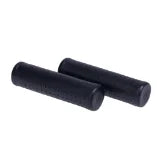The Ultimate Guide to Leather Bicycle Grips
Introduction
For centuries, humans have relied on leather to protect and enhance the surfaces of important objects. Originally used for luxurious saddles and essential tool handles, leather is now making its mark on bicycle grips—our key instrument for sustainable mobility. In this article, we'll explore why leather is the ideal material for bicycle grips and how it can elevate your riding experience. We will also debunk common myths, such as the belief that leather grips are fragile or need special protection from rain. Let's dive in.

1. Leather - A Traditional Material for Modern Comfort
Leather has been a material of choice throughout history for surfaces that interact directly with the skin, and with good reason. It boasts unparalleled tactile properties that synthetic materials simply cannot replicate. Often likened to our body's largest organ, the skin, leather symbolizes tactile excellence and comfort. This is exemplified by its use in prestigious items such as the grips of Rimowa suitcases and the steering wheel of James Bond's Aston Martin, where only genuine, high-quality leather is deemed suitable. Leather bicycle grips uphold this tradition, enriching the direct bond between rider and bike in a truly exceptional manner.

2. Durability and Longevity
The misconception that leather grips are fragile often originates from a misunderstanding. Many manufacturers opt for thin garment leather for bicycle grips due to its ease of handling, but this type of leather only provides a superficial covering over a plastic base. This thin layer, typically glued on, makes these grips vulnerable to weather conditions and contributes to the negative reputation of cheaper leather grips.
In contrast, the durability of classic full-grain leather saddles is legendary. Crafted from thick leather pieces, these saddles can endure for decades while retaining their elegant appearance. The secret to their remarkable longevity lies in the use of robust, thick leather. Much like a leather shoe sole, well-made leather grips are highly resistant to damage. They withstand constant palm abrasion, a factor that quickly wears out silicone grips and leaves them feeling sticky. Instead, high-quality leather grips develop a lustrous patina over time, maintaining their exceptional feel and appearance even after years of use.

3. Unique Tactile Properties
Leather offers a tactile experience unmatched by any synthetic material. Its warm, natural texture is akin to a human touch, providing a comfortable sensation in both summer and winter. In warmer weather, leather feels pleasantly cool, while in colder temperatures, it offers a comforting warmth. Leather excels in moisture management, absorbing excess moisture to keep your hands dry during long rides, while also providing excellent grip in dry conditions. Its surface is grippy without becoming sticky, offering a reassuring firmness crucial for safety and comfort on bicycle handlebars.
Furthermore, leather grips adapt to the contours of your hands over time, much like a well-worn shoe or an old baseball glove. This unique characteristic ensures a personalized fit that enhances comfort and control. The more you use your leather grips, the more they conform to your hands, fostering a deeper appreciation and enjoyment of your riding experience. These dynamic qualities establish leather grips as the preferred choice for anyone who prioritizes quality and comfort.

4. Resistance to Rain and Moisture
One of the initial concerns among new users of leather grips is "Do I need to protect my leather grips from rain?". Surprisingly, leather is fundamentally resilient to moisture, a trait evident in the longstanding use of leather in shoes and shoe soles, which endure constant exposure to high moisture levels without issue. Leather bicycle grips share this durability: they can withstand getting wet without sustaining damage. While continuous exposure to rain should be avoided, normal weather conditions pose no threat to well-maintained leather grips. The strength and resilience of thick, high-quality leather ensure they remain robust and durable over time.
5. Maintenance: Less Is More for Leather Grips
The second common question from users of leather grips is "Do I need to care for my leather grips in any special way?". Surprisingly, the answer is often no. Leather bicycle grips are unique in this regard. Unlike leather shoes, which benefit from occasional treatments with leather care products, leather bicycle grips typically require no special maintenance if used regularly. The natural oils from your palms provide the best nourishment for the leather grips over time. As such, they generally do not need additional treatments. However, if you wish to occasionally indulge your grips, applying a colorless leather care product like Brooks Proofide leather wax can enhance their condition. It's important to avoid waterproofing sprays, as they are unnecessary and may introduce unwanted chemicals to your hands.
Conclusion: Leather Grips – Elegance and Quality in Motion

Leather grips offer a combination of traditional aesthetics, unmatched comfort, and long-lasting quality. They are not just a stylish accessory for your bike but also enhance the riding experience with their unique tactile and durable properties. By choosing leather grips, you select a material that becomes more beautiful over time and tells a story with every ride.








